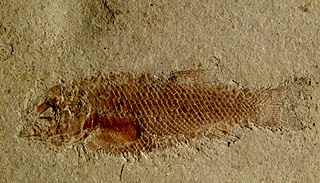Axelia is an extinct genus of prehistoric lobe-finned fish, which belonged to the family of Coelacanthidae. It lived during the Smithian age of the Early Triassic epoch in what is now Spitsbergen, Svalbard. Fossils were found in the "Fish Niveau" of the Lusitaniadalen Member of the Vikinghøgda Formation.

Whiteia is an extinct genus of prehistoric coelacanth fish which lived during the Triassic period. It is named after Errol White.

Dictyopyge is an extinct genus of prehistoric freshwater bony fish. Two species are recognized, D. macrurus and D. meekeri, which both lived during the Carnian age in what is now Virginia, United States.

Rhabdolepis is an extinct genus of prehistoric bony fish that lived during the Asselian age of the Cisuralian epoch in what is now Germany and France (Burgundy).
Paralogoniscus is an extinct genus of prehistoric bony fish that lived during the Cisuralian epoch in what is now East Kazakhstan, Kazakhstan. It could reach body lengths of up to ca. 50 cm (20 in).
Sassenia is an extinct genus of prehistoric coelacanth lobe-finned fish that lived during the Early Triassic epoch in what is now East Greenland and Svalbard.
Spermatodus is an extinct genus of prehistoric coelacanth lobe-finned fish, which lived during the Artinskian age of the Cisuralian epoch in what is now Oklahoma and Texas, United States.
Scleracanthus is an extinct genus of prehistoric coelacanth lobe-finned fish. It lived during the Early Triassic epoch in what is now Spitsbergen, Svalbard.

Acentrophorus is an extinct genus of prehistoric ray-finned fish from the Wuchiapingian of England and Germany (Kupferschiefer). There may also be a Triassic occurrence in Australia.

Aeduella is an extinct genus of prehistoric freshwater bony fish that lived during the Gzhelian and Asselian-Sakmarian ages in what is now France, Germany, Switzerland and the Czech Republik.
Alleiolepis is an extinct genus of prehistoric bony fish, which lived during the Ladinian age of the Middle Triassic epoch in what is now Franconia, Germany. It was first named Leiolepis, but because this genus name is preoccupied by an extant lizard, the genus name of the Triassic fish was changed to Aleiolepis.

Boreosomus is an extinct genus of Triassic ray-finned fish. It was first described from the Arctic island of Spitsbergen, but was later also discovered in other parts of the world. The type species is Boreosomus arcticus.

Colobodus is an extinct genus of Triassic bony fish of the family Colobodontidae and order Perleidiformes. Fossils have been found in Europe and China. It could reach body lengths of about 70 cm.
Westollia is an extinct genus of prehistoric bony fish that lived during the Asselian age in what is now Thuringia, Germany.
Uydenia is an extinct genus of prehistoric bony fish from the Cisuralian of Kazakhstan.

Sargodon is an extinct genus of neopterygian ray-finned fish that lived during the Middle and Late Triassic epochs in what is now Europe.

Gyrolepis is an extinct genus of prehistoric ray-finned fish from the Middle-Late Triassic epochs in what is now Europe. It is known both from complete specimens and isolated skeletal elements, such as scales or teeth.
Gardinerichthys is an extinct genus of freshwater actinopterygian bony fish from the Cisuralian epoch of Germany, and the middle Permian of India. The type species, G. latus, was discovered in Asselian aged layers (Rotliegend).

Bourbonnella is an extinct genus of prehistoric freshwater bony fish that lived during the late Mississippian (Carboniferous) and Asselian in what is now Burgundy, Rhineland-Palatine (Germany) and the Czech Republik.

Ardoreosomus is an extinct genus of ray-finned fish. It was described from the Induan aged Candelaria Formation of Nevada, United States, which was located near the equator during the Early Triassic epoch. It contains only one species, A. occidentalis (monotypy).
















